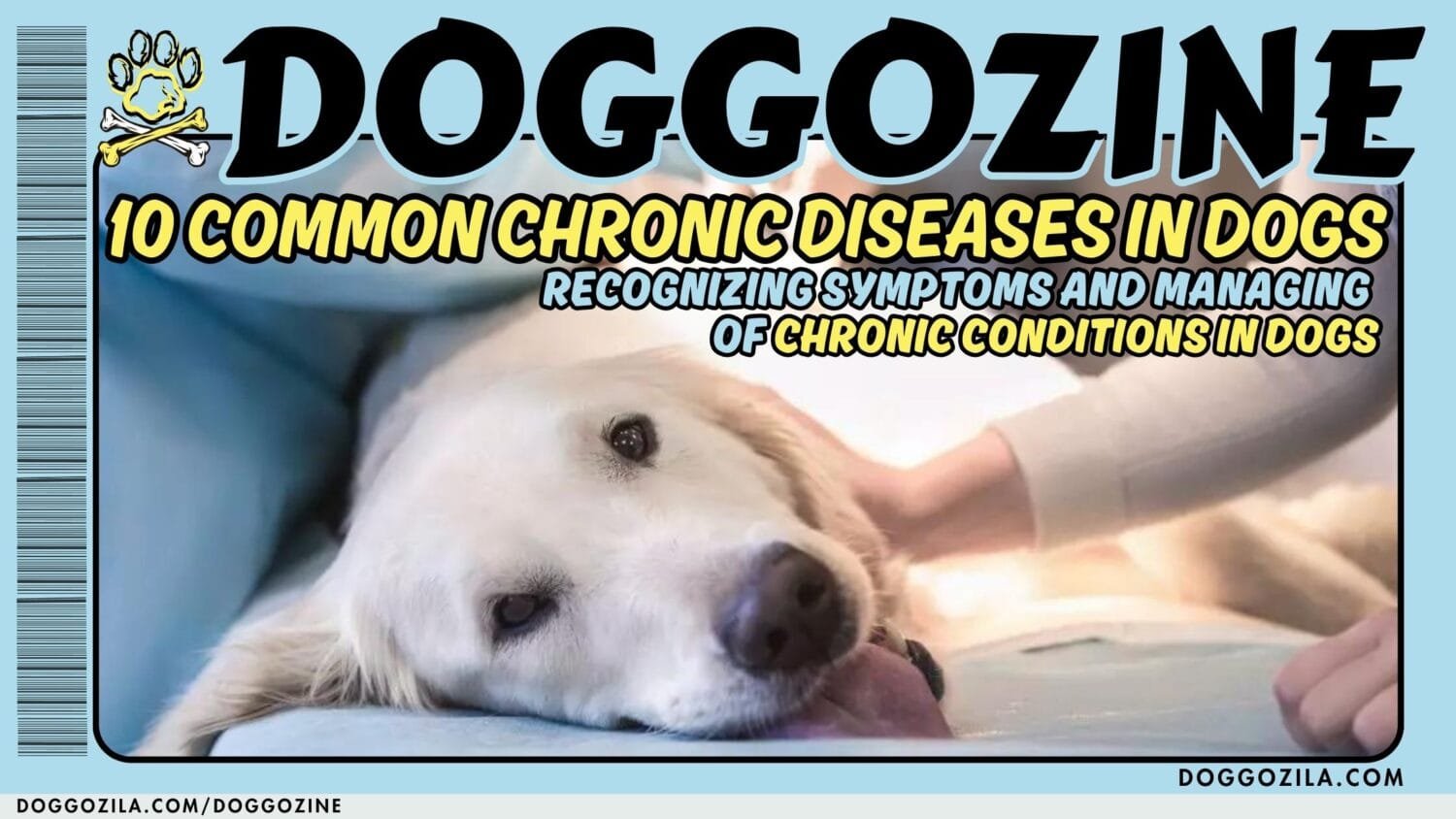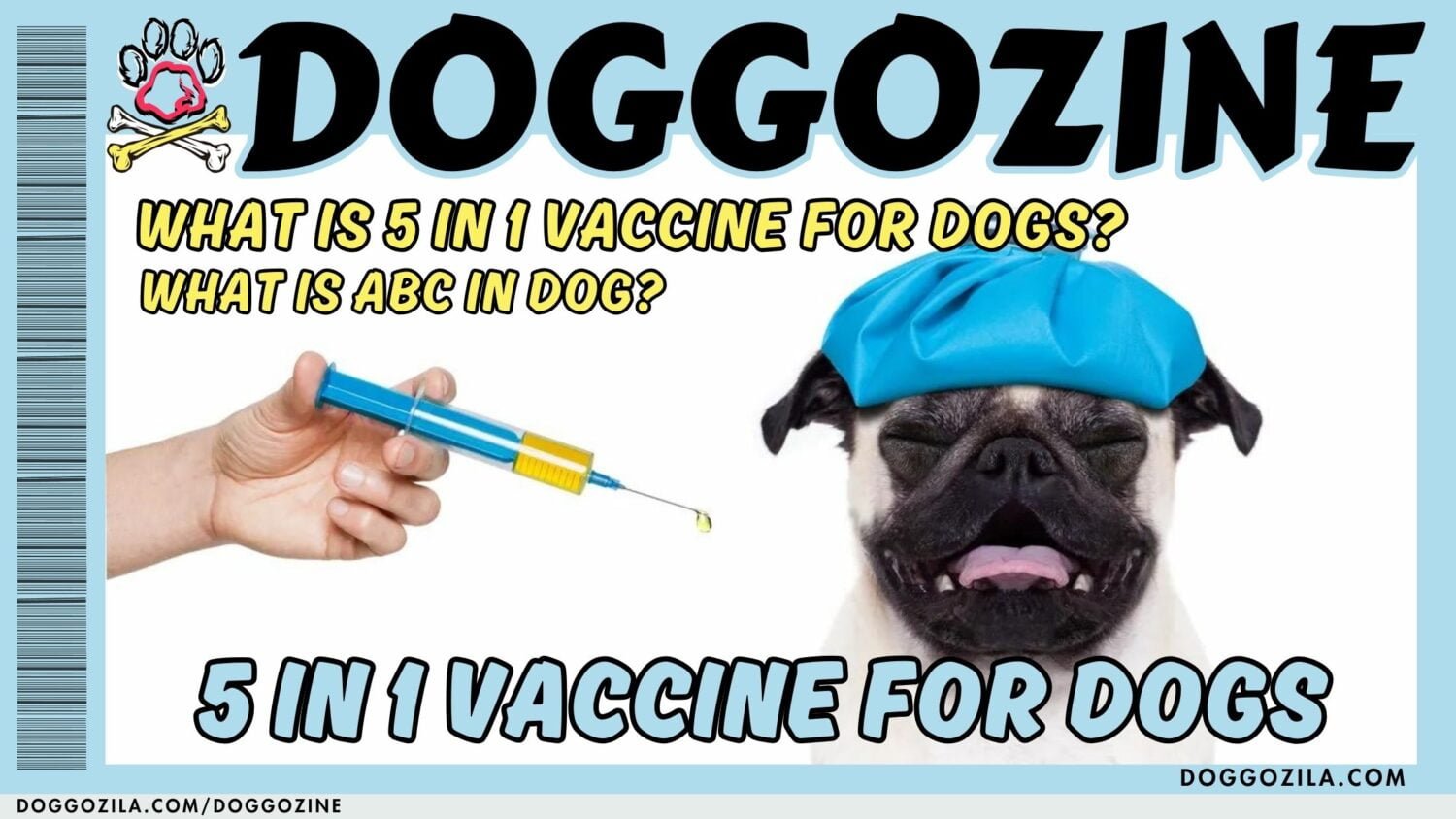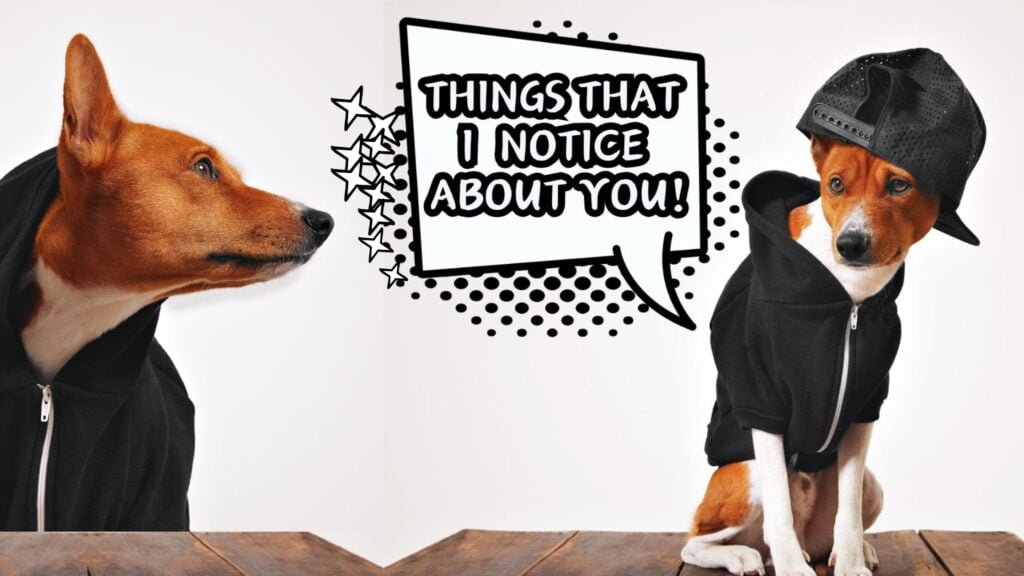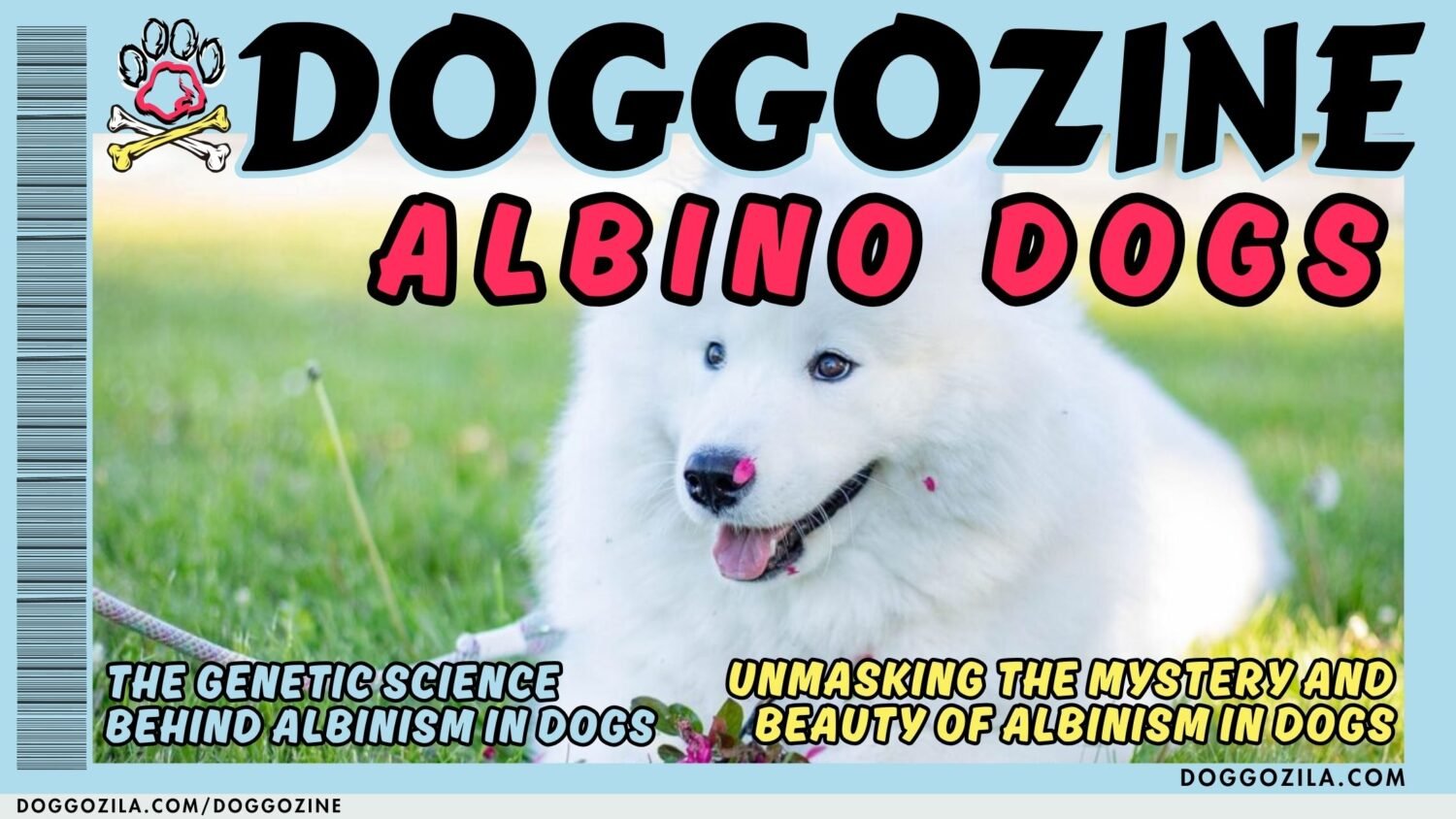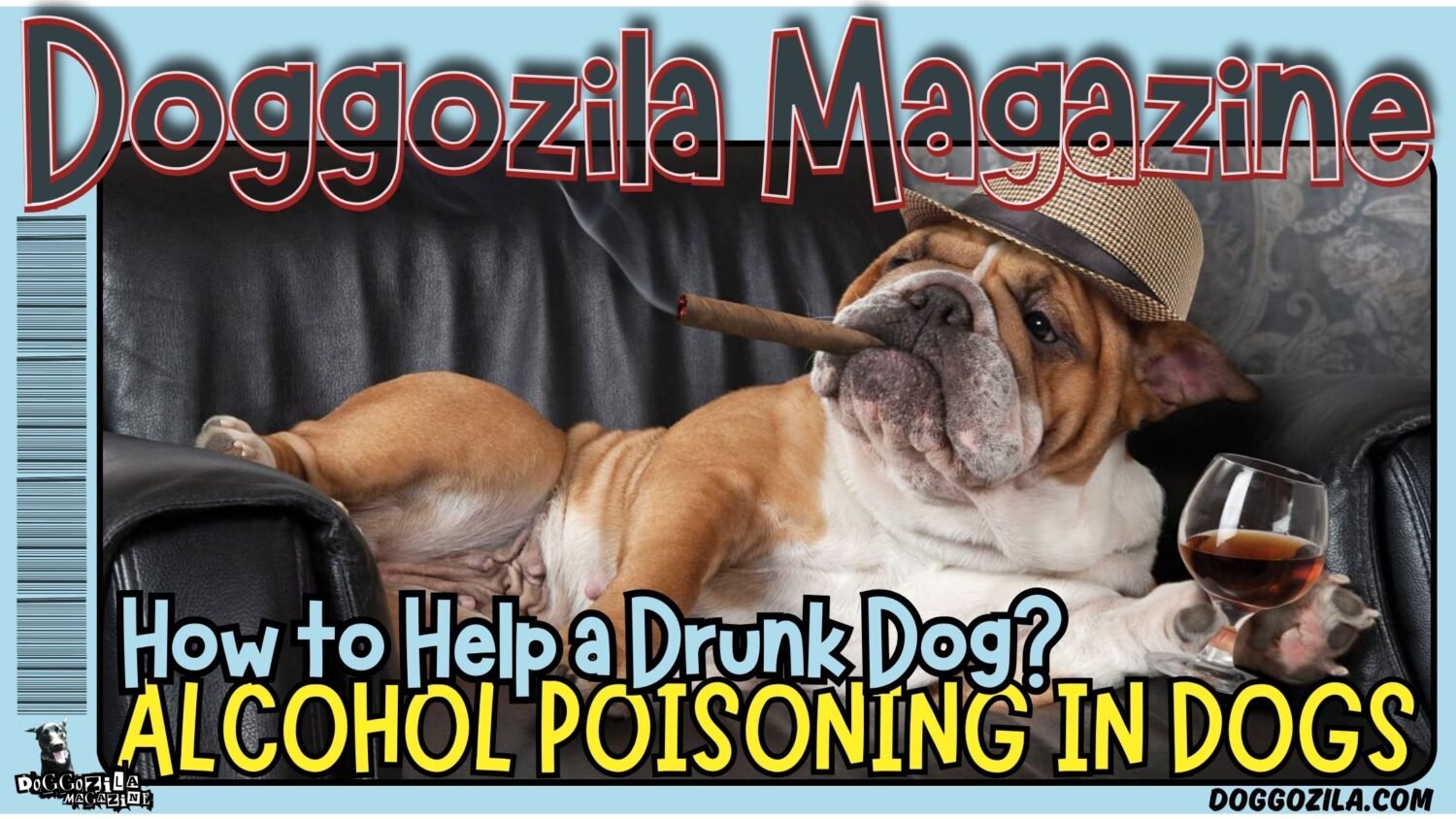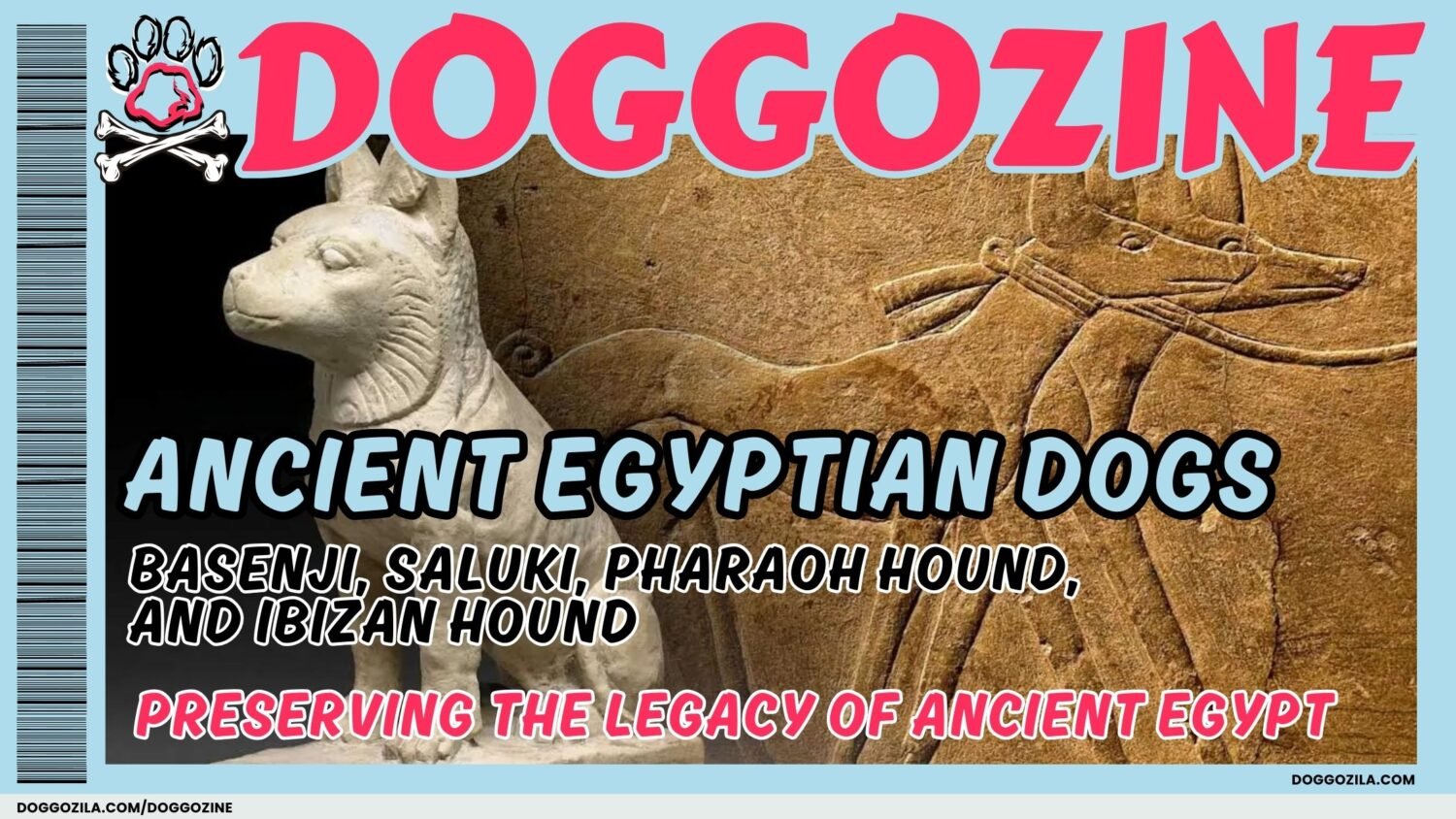Picture this: You’re at the dog park, and two dogs are rolling around, growling, and snapping at each other. So, are these dogs playing or fighting? It’s a question every dog owner has asked at least once. Understanding the difference between play and aggression is crucial for keeping your pup safe and ensuring everyone has a good time.
In this article, we’ll break down the subtle (and not-so-subtle) signs that separate playful pups from potential brawlers. Plus, we’ll dive into real-life examples, case studies, and tips to help you become a canine body language expert. Let’s get started!

UNDERSTANDING THE BEHAVIOR OF DOGS: FIGHTING VS. PLAYING
Understanding dog behavior is crucial for every dog owner, as it enables them to foster a safe and harmonious environment for their pets and themselves. Dogs exhibit a wide range of behaviors that can sometimes be misinterpreted, particularly when distinguishing between playing and aggressive fighting. Recognizing the nuances that separate these behaviors is vital to ensure the well-being of both dogs and their human companions.
How to Tell If Dogs Are Playing or Fighting
Playful interactions between dogs are characterized by specific signals, such as the play bow, relaxed body posture, and alternating movements. These signals indicate that the interaction is a friendly one, aimed at building social bonds rather than causing harm.
Conversely, fighting may display more aggressive postures, such as raised hackles, bared teeth, or stiff body language, which can signify a potential threat. By understanding these different cues, dog owners can better assess their pets’ interactions with other dogs and intervene when necessary.
Furthermore, socialization plays a significant role in shaping a dog’s behavior. Dogs that are well-socialized tend to exhibit more appropriate play behavior, reducing the risk of misunderstandings with other dogs.
Tell If Dogs Are Playing or Fighting with Observing Their Interactions
It is essential for owners to expose their dogs to different environments and other animals, allowing them to learn the boundaries of acceptable play and recognize the warning signs of aggression. In addition, observing their own dog’s behavior during interactions can provide valuable insights into whether they are engaging in playful activity or displaying signs of distress or confrontation.
Ultimately, understanding dog behavior is not just about distinguishing between fighting and playing; it encompasses a broader awareness of canine communication. This knowledge empowers dog owners to be proactive in managing their pets’ social experiences, promoting healthier relationships between dogs and humans, thereby enhancing the overall experience of pet ownership.
🔑 Key Points: Understanding these nuances in canine behavior can greatly aid in distinguishing between aggression and playful behavior, fostering safer interactions between dogs and humans.
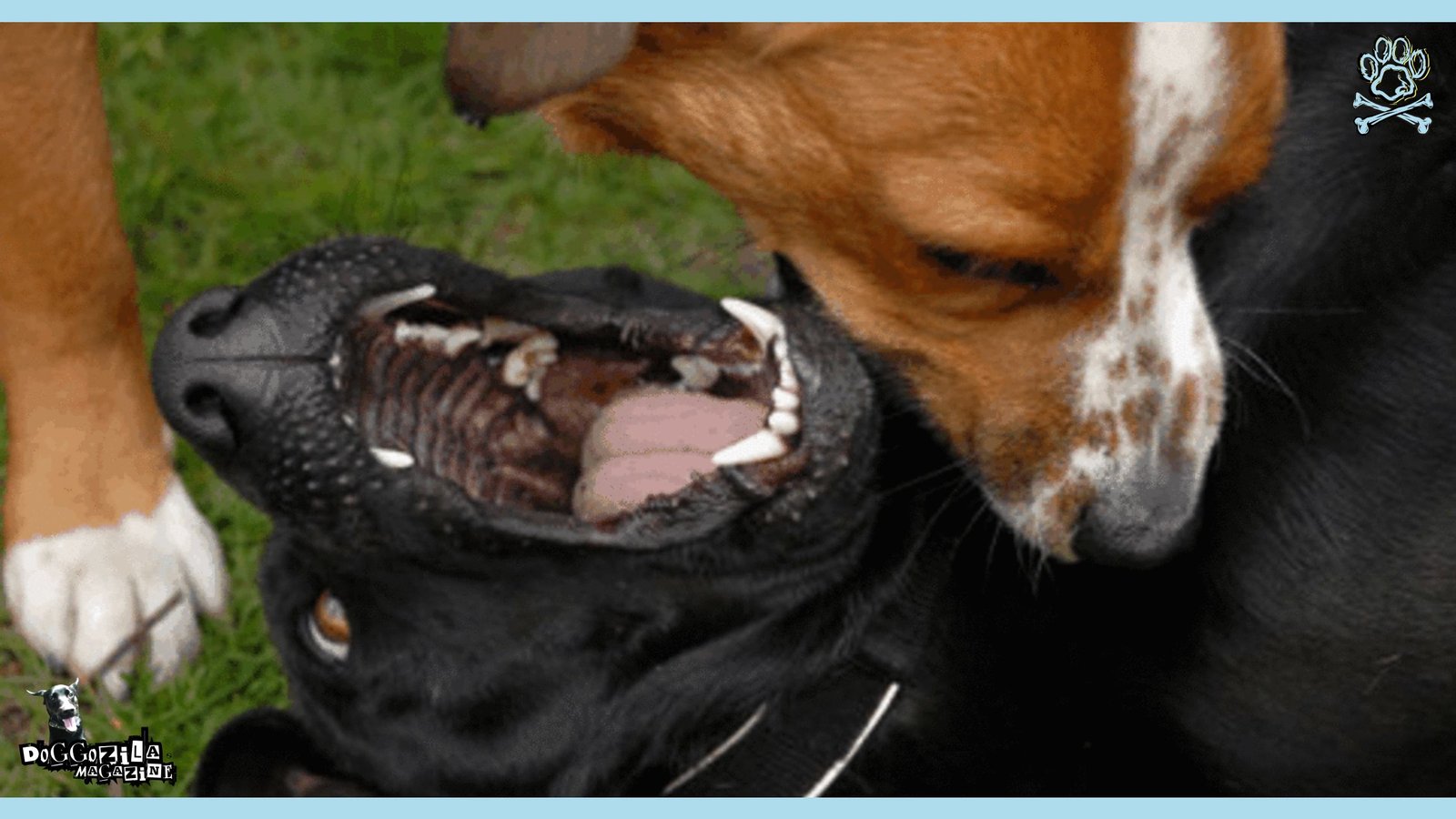
WHEN DOGS ARE FIGHTING: SIGNS OF TROUBLE AND NO PLAYING
While play can look rough, real fights are unmistakable once you know what to look for. Aggressive behavior is tense, focused, and often escalates quickly. Here’s how to tell if dogs are fighting.
Key Signs That Things Have Taken a Turn for The Worse
- Stiff, Tense Body Language: Fighting dogs hold their bodies rigid, with their weight shifted forward. Their muscles are tense, and their movements are deliberate.
- Deep, Guttural Growls: Aggressive growls are low-pitched and menacing. They’re a clear warning to back off.
- Snarling and Bared Teeth: When a dog bares their teeth and curls their lips, it’s a sign of aggression. This is not a playful gesture.
- Focused, Intense Staring: Dogs in a fight lock eyes and stare each other down. There’s no playful bouncing or role reversal here.
- Lack of Breaks: Fights are relentless. Dogs don’t pause to catch their breath or check in with their owners. They’re fully focused on the conflict.
- Injuries or Blood: While rough play can sometimes lead to minor scratches, fights often result in more serious injuries. If you see blood or hear yelps of pain, it’s time to intervene.
Real-Life Example: Rocky and Duke’s Dispute
Rocky, a German Shepherd, and Duke, a Rottweiler, had a tense encounter at the dog park. Both dogs were on leashes when they started growling and lunging at each other. Their bodies were stiff, and their owners noticed deep, guttural growls.
Despite attempts to calm them down, the situation escalated into a full-blown fight. The owners had to separate them, and both dogs suffered minor injuries. It was a clear case of aggression, not play.
🔑 Key Points: It is important to understand that aggression is often a response to fear or anxiety. Therefore, recognizing these signs can provide vital insights into a dog’s emotional state, aiding in the management of the behavior and promoting a safer environment for all involved.
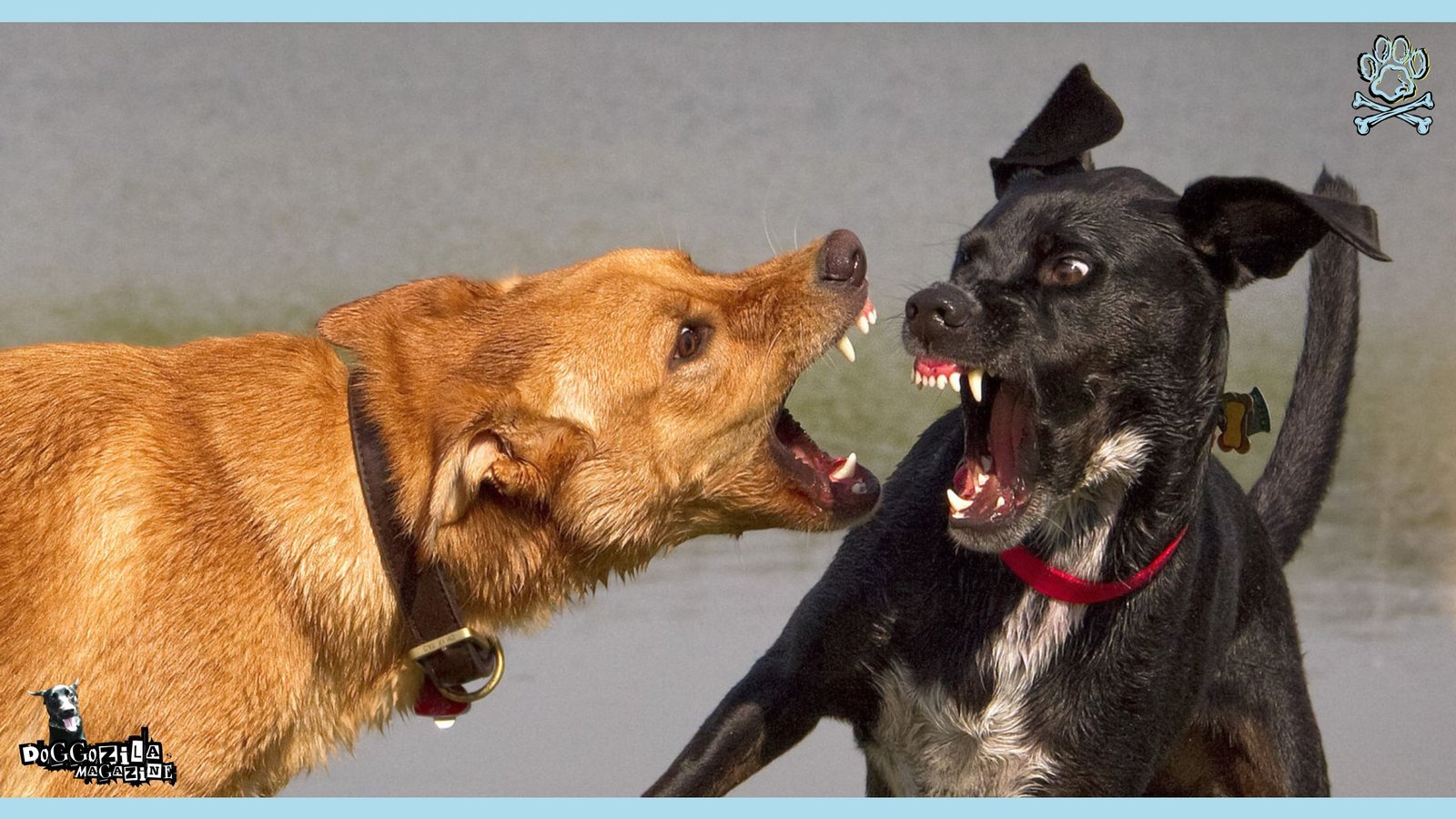
KEY INDICATORS OF DOGS FIGHTING AND NOT PLAYING
Recognizing the signs of dog fighting is crucial for ensuring the safety of both pets and their owners. Dogs have a range of aggressive behaviors that can be mistaken for playfulness. Understanding these behaviors can help in distinguishing between a healthy interaction and a potential fight.
Presence of Loud Guttural Growls and Biting
One of the primary indicators of a dog fight is the presence of loud guttural growls. This deep, throaty sound often signifies that a dog is feeling threatened or aggressive. When accompanied by rapid movements, such as lunging or chasing, it becomes clear that the situation may be escalating toward a fight.
Another significant indicator is biting, which is often more intense and forceful than in a playful encounter. While dogs typically engage in light, mouthing behaviors during play, a fight will see dogs use a more aggressive bite. Additionally, thrashing movements where dogs are seen shaking or tossing their heads while biting can indicate heightened aggression and a move toward fighting.
Raised Hackles, Pinned Ears with Stiff Posture and Lowered Stance
Visual cues are equally important in identifying aggressive behaviors in dogs. Raised hackles, which appear when a dog’s fur stands on end along its back, indicate heightened arousal and potential aggression. Pinned ears, where a dog’s ears are laid back against its head, often signify submission or fear, and in conjunction with other aggressive behaviors may suggest that a confrontation is brewing.
Furthermore, tense body language, such as a stiff posture or a lowered stance, can signal distress and an unwillingness to engage in friendly behavior. These signs should be taken seriously, as they are critical for distinguishing between playful interactions and potentially dangerous dog fights.
🔑 Key Points: Playful dogs often take turns and display behaviors such as bowing or lightly tapping each other with their paws, fostering a fun and joyful ambiance.

WHEN DOGS ARE PLAYING: IT’S ALL FUN AND GAMES EVEN IF IT LOOKS LIKE FIGHTING
Playtime is essential for dogs. It helps them socialize, burn off energy, and strengthen bonds with other dogs (and humans). But play can look intense, especially to the untrained eye.
How To Tell If Your Dog Is Just Having a Blast
- The Play Bow: This is the universal sign of “Let’s play!” A dog will lower their front legs while keeping their rear end up in the air. It’s like saying, “I’m ready to rumble—but only for fun!”
- Loose, Wiggly Movements: Playful dogs move in exaggerated, bouncy ways. Their bodies are relaxed, and their tails wag freely. Think of it as the dog version of a happy dance.
- Role Reversing: During play, dogs often take turns being the “chaser” and the “chased.” One moment, your dog might be on top, and the next, they’re rolling over to let the other dog “win.”
- Soft, Playful Growls: Yes, dogs growl when they play, but it’s usually higher-pitched and less intense than an aggressive growl. It’s more like a playful “rawr!” than a serious warning.
- Pauses and Breaks: Playful dogs frequently take breaks to catch their breath or check in with their surroundings. These pauses are a good sign that the interaction is friendly.
Real-Life Example: Max and Bella at the Park
Max, a Golden Retriever, and Bella, a Border Collie, are regulars at the local dog park. One day, they start chasing each other, growling and nipping at each other’s tails. At first glance, it looks like a fight, but their owners know better.
Max drops into a play bow, and Bella responds with a playful bark. They take turns chasing each other, and every few minutes, they pause to wag their tails and catch their breath. It’s clear they’re just having fun.
🔑 Key Points: Playful dogs also take frequent breaks. They might pause to catch their breath, check in with their owners, or simply wag their tails before diving back into the fun.
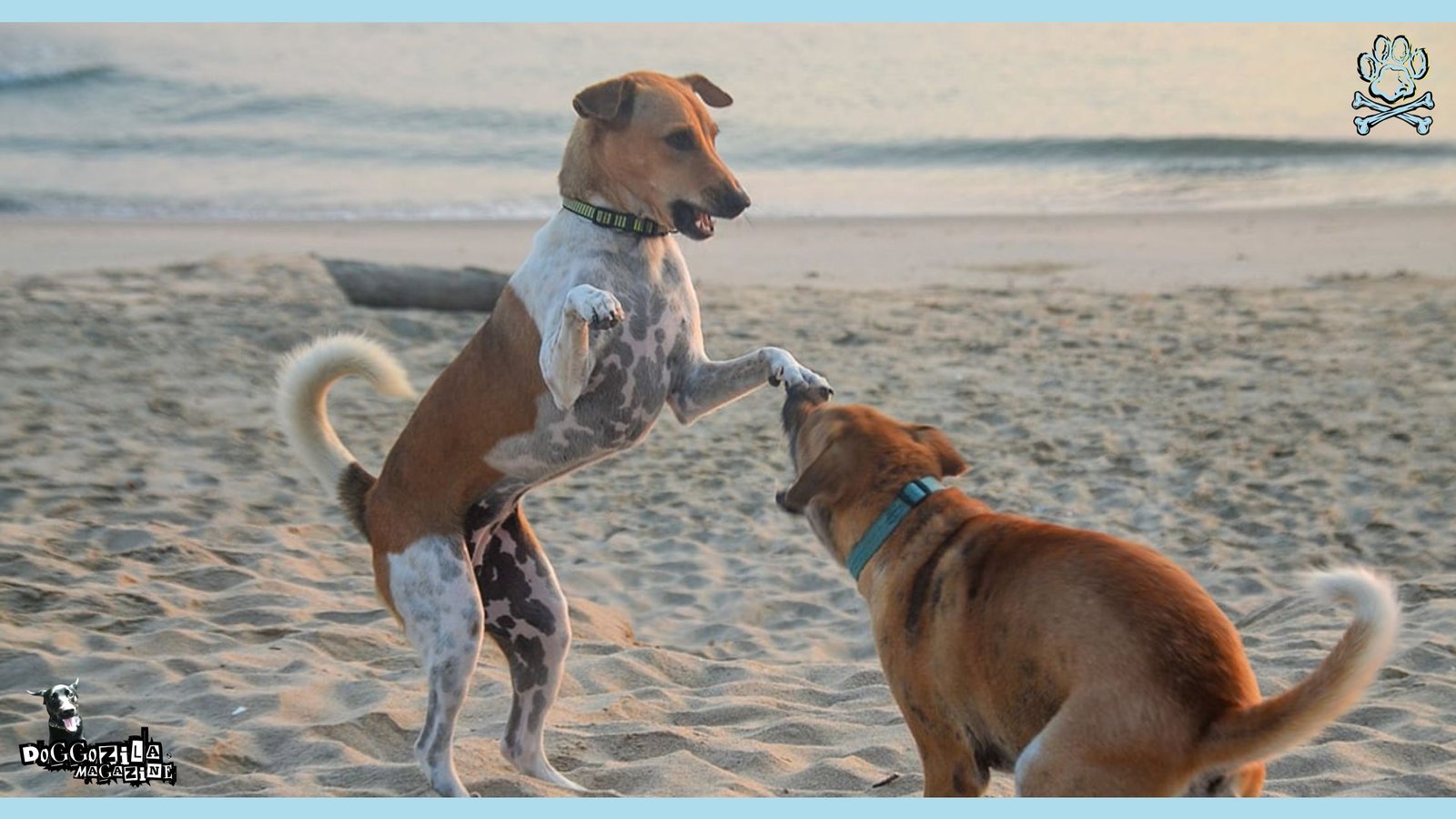
SIGNS OF DOGS PLAYING AND NOT FIGHTING
Understanding canine behavior is essential for pet owners, particularly when distinguishing between playful and aggressive interactions. Playful behaviors in dogs can manifest in several ways, reflecting their natural instincts and socialization habits. Key signs indicating that a dog is engaging in play involve specific body language and actions that are markedly different from aggressive behavior.
Cheek Biting, Scruff Holding and Wrestling
One prevalent behavior observed in dogs during play is cheek biting. This is often characterized by gentle nipping at another dog’s face or mouth without causing pain or distress. Alongside this, dogs may exhibit “scruff holding,” a behavior where they lightly grasp the loose skin on the nape of another dog’s neck. This action is typically a sign of playful engagement, showcasing trust rather than dominance.
Wrestling is another common activity among dogs that signals playfulness. During a wrestling match, dogs will often roll around on the ground, occasionally biting at each other in a friendly manner. The sounds and movements during these interactions can reinforce the fun atmosphere, as dogs engage energetically while remaining relaxed and loose in their movements.
The Play Bow and Happy Panting
Body language plays a crucial role in identifying playful behavior. Dogs often execute the ‘play bow,’ where they lower their front legs while keeping their rear in the air, signaling their eagerness to engage. Other behaviors such as sneezing, which often punctuates play, and happy panting serve as indicators of a dog’s excitement and enjoyment. These happy cues contribute to a positive interactive experience, highlighting the absence of any aggression.
By recognizing these playful behaviors and cues, dog owners can ensure their pets engage in healthy social interactions, fostering strong bonds and reducing misunderstandings that may arise from misinterpreting aggressive postures. Through observation, owners can facilitate a safe and enjoyable play environment for their dogs.
Understanding the Context of Interactions
When observing interactions between dogs, it is crucial to consider the context in which these behaviors occur. An environment plays a pivotal role in shaping the dynamics of how dogs engage with one another. For instance, a dog park, with its many distractions and unfamiliar scents, may amplify excitement levels and encourage play.
Conversely, a more confined setting, such as a home, may lead to heightened stress or territorial behaviors, which could be misinterpreted as aggression. Understanding the surrounding context can significantly enhance one’s ability to differentiate between playful banter and fighting.
The History Between the Dogs Involved in the Interaction
Another essential factor to consider is the history between the dogs involved in the interaction. Dogs that have previously engaged in friendly play may display behaviors that look similar to those seen during a dispute. These may include growling, barking, and play-bowing.
However, if two dogs have a history of conflict, similar actions may escalate quickly into a fight. Therefore, knowing the background and previous encounters between the dogs is vital for accurately interpreting their present behavior. Moreover, the presence of potential triggers can influence the behavior of the dogs. Triggers can include the presence of certain people, other animals, or even specific toys that one dog may be guarding.
In some cases, the introduction of a new element in the environment can provoke defensive or aggressive reactions, making it essential for dog owners to remain vigilant about the external factors at play. By paying attention to these contextual variables, dog owners can gain greater insight into whether their pets are simply engaging in play or if they are entering a more serious altercation.
🔑 Key Points: Key signs indicating that a dog is engaging in play involve specific body language and actions that are markedly different from aggressive behavior.

THE FINE LINE: WHEN FROM PLAYING DOGS TURNS INTO FIGHTING
Sometimes, when dogs are playing, can escalate into a fighting, especially if one dog misreads the other’s signals or if one dog becomes overstimulated. If one dog is clearly not enjoying the interaction—hiding, yelping, or trying to escape—it’s time to step in. Play should have a natural ebb and flow. If the intensity keeps ramping up without breaks, it could turn into a fight. Playful nipping is normal, but if one dog is biting too hard or targeting sensitive areas like the face or neck, it’s a red flag.
How To Spot When Dogs from Playing Start Fighting
- One-Sided Play: If one dog is clearly not enjoying the interaction (e.g., hiding, yelping, or trying to escape), it’s time to step in.
- Escalating Intensity: Play should have a natural ebb and flow. If the intensity keeps ramping up without breaks, it could turn into a fight.
- Overly Rough Behavior: Playful nipping is normal, but if one dog is biting too hard or targeting sensitive areas (like the face or neck), it’s a red flag.
Case Study: Luna and Charlie’s Playdate Gone Wrong
Luna, a playful Labrador, and Charlie, a shy Beagle, were having a playdate at home. At first, everything seemed fine—they were chasing each other and play-bowing. But as the playdate went on, Luna became more rambunctious, and Charlie started to show signs of stress.
He yelped and tried to hide under the couch, but Luna didn’t take the hint. The situation quickly escalated, and Luna accidentally nipped Charlie’s ear, causing a minor injury. The owners intervened and gave both dogs a break. It was a reminder that even friendly play needs supervision.
🔑 Key Points: Sometimes, play can escalate into a fight, especially if one dog misreads the other’s signals or if one dog becomes overstimulated. Playful nipping is normal, but if one dog is biting too hard or targeting sensitive areas like the face or neck, it’s a red flag.
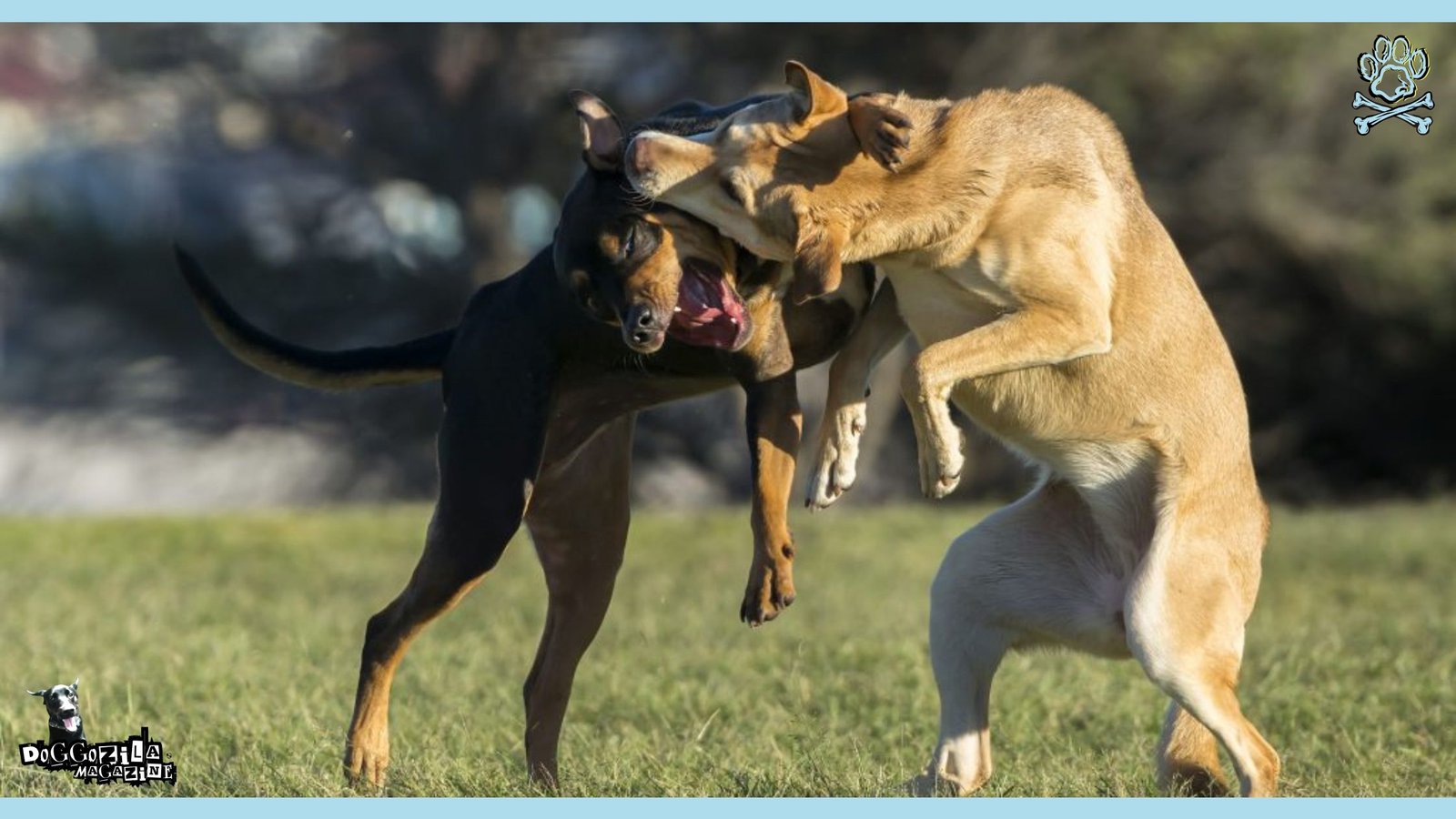
TEACHING OWNERS TO RECOGNIZE IF THEIR DOGS ARE PLAYING OR FIGHTING
Understanding dog behavior, particularly the distinction between if dogs are playing and fighting, is crucial for owners to ensure a safe environment for both their pets and other animals. Observing a dog’s body language plays an essential role in differentiating between these two forms of interaction.
First Signal of Dogs Playing is the Play Bow
One key indicator of playful behavior is the “play bow,” where a dog stretches its front legs forward while keeping its rear end up, signaling a desire for fun and engagement.
In contrast, a dog that feels threatened or aggressive may display a stiff body posture, lowered ears, and a raised tail. Recognizing these signals can help owners assess the nature of their dog’s interactions with other dogs.
Listen Carefully to Dog’s Vocalizations
Vocalizations also serve as valuable clues in identifying a dog’s behavior. Playful dogs often engage in barks that are high-pitched and excited, while aggressive growls are deeper and resonate with a sense of warning.
It is important to listen carefully to these vocalizations! A sudden shift from cheerful barks to low growls may signify that play has escalated into a more serious encounter. Therefore, owners should stay vigilant during their dog’s interactions.
Observing The Context of the Interactions
Another effective method for recognizing behavior is observing the context in which the interactions occur. For instance, if dogs are chasing each other while alternating roles as the chaser and the chased, this generally indicates play.
Conversely, if one dog consistently shows signs of stress, such as turning away or attempting to escape, it may signify that the interaction is becoming too intense or aggressive. Establishing a routine of observation during playtime will enhance the owner’s ability to discern these behaviors accurately and swiftly.
By paying close attention to both body language and vocalizations, dog owners can foster positive play experiences while effectively managing any encounters that may pose a risk of aggression.

When Aggression Can Escalate
Understanding the triggers that may cause a playful dog to transition into aggressive behavior is vital for dog owners and handlers. A seemingly harmless play session can rapidly turn aggressive if specific stressors are present.
Certain situations, environments, and interactions can provoke a response that may not align with a dog’s typical behavior. Identifying these potential triggers is essential to prevent escalation and ensure a safe environment for all involved.
Over-stimulation is a common factor that can lead to aggressive reactions in dogs. When a dog becomes too excited during play, it may struggle to manage its energy levels, resulting in nipping or barking that resembles aggression.
Signs of over-stimulation include excessive panting, hyperactivity, or a fixated gaze. If you notice these behaviors during playtime, it is crucial to intervene calmly and redirect the dog’s focus to reduce their excitement.
Beware of External Factors
External factors can also play a significant role in a dog’s behavior. For example, the presence of other dogs, loud noises, or even unfamiliar environments may contribute to heightened anxiety levels, pushing a playful dog toward aggression.
If a dog feels threatened or cornered by another animal or person, it may resort to aggressive behaviors as a defense mechanism. Monitoring the dog’s reactions to these stressors can provide insight into when they may become uncomfortable.
Finally, underlying health issues can also influence a dog’s behavior. Pain or discomfort can lead a normally playful dog to react aggressively during play.
Regular veterinary check-ups are essential to ensure that health-related factors are not contributing to aggression. By maintaining awareness of these triggers and signals, owners can better manage their dog’s playtime, promoting positive interactions while minimizing the risk of aggression.
🔑 Key Points: Observing a dog’s body language plays an essential role in differentiating between these two forms of interaction. Patience, consistency, and understanding the unique nature of each dog are essential elements in this training journey.
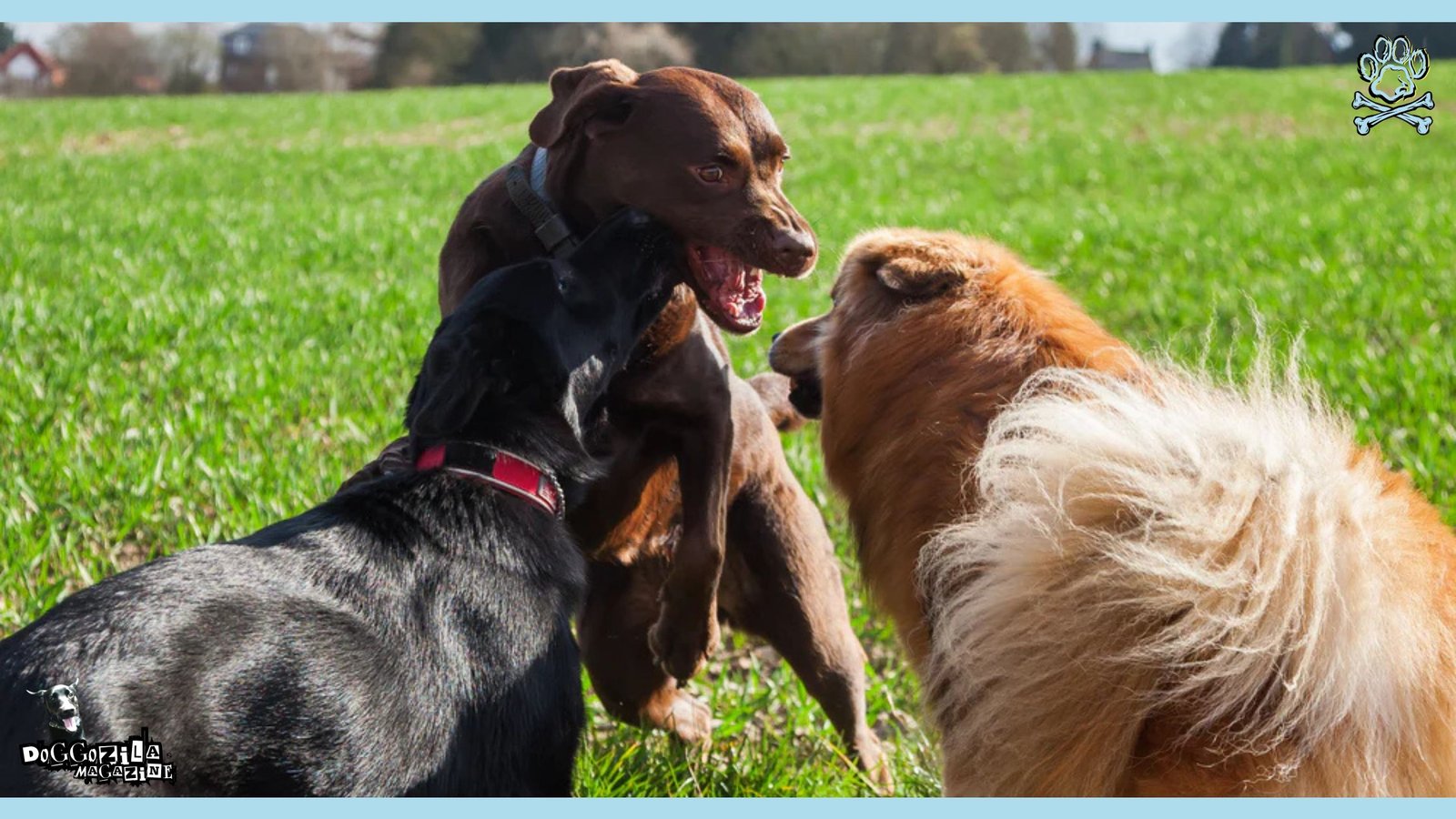
TRAINING: ENCOURAGING PLAYING AND REDUCING FIGHTING IN DOGS
Training plays a pivotal role in shaping a dog’s behavior, particularly when distinguishing between aggressive and playful tendencies. When training is a part of a daily routine of a dog’s life, it gives them a sense of understanding and awareness about their interaction with everything or everyone in the environment they are at any given moment.
Proper Socialization for Positive Dog Play
One key aspect of fostering positive play is proper socialization. Exposing dogs to various environments, animals, and people from a young age helps them develop essential social skills. Positive exposure assists in reducing fear and anxiety, which can often manifest as aggression. During socialization, it is crucial to create controlled scenarios where dogs can interact safely, allowing them to learn appropriate behaviors in a variety of contexts.
To Encourage Desired Behaviors in Dogs, Use Positive Reinforcement
Positive reinforcement is another fundamental technique to encourage desired behaviors in dogs. This training approach involves rewarding dogs with treats, praise, or playtime when they exhibit playful and friendly behavior.
For example, when a dog plays gently with another dog or responds well to cues during play, rewarding them reinforces this behavior, creating a clear association between positive actions and rewards. It is important to remain consistent and immediate with rewards to ensure the dog understands which behaviors are acceptable.
You May Need Support from Professional Dog Trainer or a Behaviorist
In some cases, despite your best efforts, a dog may continue to display aggressive behavior. In such instances, collaborating with a professional dog trainer or a behaviorist can provide added support. These experts can create tailored training programs that address specific behavioral concerns, employing techniques that enhance understanding and communication between the dog and owner.
Additionally, they can assist in identifying triggers that may lead to aggression, allowing for proactive management strategies to be implemented. Ultimately, a combination of socialization efforts, positive reinforcement, and professional guidance can contribute significantly to promoting playful interactions while minimizing aggressive tendencies in dogs. Patience, consistency, and understanding the unique nature of each dog are essential elements in this training journey.
🔑 Key Points: One key aspect of fostering positive play is proper socialization. Positive reinforcement is another fundamental technique to encourage desired behaviors in dogs. When dogs continue to display aggressive behavior contact professional dog trainer or a behaviorist.

HOW TO REACT: RESPONDING TO AGGRESSIVE VS PLAYFUL DOGS
Understanding how to interact with dogs exhibiting aggressive versus playful behavior is crucial for ensuring both your safety and the welfare of the dog. When faced with a playful dog, the approach should be welcoming and engaging.
Responding to Playful Dogs
Playful dogs typically exhibit loose body language, wagging tails, and a relaxed demeanor. In such cases, you can engage in light play with toys or participate in simple games like fetch. However, always remain observant of the dog’s cues!
If it suddenly becomes overly excited or starts showing signs of over-stimulation, such as growling or excessive barking, it may be best to take a step back. Always ensure there is enough space for the dog to express itself without feeling cornered.
Responding to Aggressive Dogs
On the other hand, responding to aggressive dogs requires a more cautious approach. Signs of aggression can include raised hackles, bared teeth, intense barking, and a stiff posture. If you encounter a dog displaying these behaviors, it is essential to remain calm and avoid direct eye contact, which may provoke the animal further.
Slowly back away from the situation, giving the dog the space it needs to feel secure. Never attempt to touch or reassure an aggressive dog, as your actions could be misinterpreted and lead to an escalation of the situation.
Ensure Dog’s Play Not to Cross Over into Aggressive Behavior
In both scenarios, prioritizing safety is paramount. For playful dogs, ensure that their play remains appropriate and does not cross over into aggressive behavior. For aggressive dogs, remember to observe from a distance and report any concerning behaviors to a professional dog trainer or animal control if necessary. By understanding the differences in behavior and responding appropriately, you can foster a safe environment for yourself and the dogs around you.
🔑 Key Points: For playful dogs, ensure that their play remains appropriate and does not cross over into aggressive behavior. For aggressive dogs, remember to observe from a distance and report any concerning behaviors to a professional dog trainer or animal control if necessary.

INTERVENING SAFELY IN DOG INTERACTIONS
When observing dog interactions that may lead to fighting, it is essential for owners and bystanders to recognize the signs of escalating behavior and intervene safely. First and foremost, it is crucial to remain calm. A panicked reaction can heighten tension among the dogs and make the situation more challenging to control.
Assess The Interaction Carefully
Assess the interaction carefully to differentiate between play and aggression. To know if dogs are playing or fighting, look for signs such as growling, bared teeth, or stiff body posture, which may indicate a shift toward a more serious conflict.
In circumstances where intervention is necessary, utilizing a calm and authoritative voice to command the dogs can be effective. Commands such as “sit” or “leave it” can redirect their attention momentarily. If verbal commands do not achieve the desired outcome, employing physical barriers can help.
These may include using objects like a dog leash, a water spray bottle (with caution), or even throwing a toy at a distance to divert their focus. However, owners should be aware that rushing into the fray or attempting to separate fighting dogs using hands can lead to injury.
Utilization of the Leash Technique
Another method is the utilization of the “leash technique,” where owners hold their dog at a reasonable distance while attempting to distract the dog(s) by making loud noises, clapping hands, or employing a firm recall command.
Regardless of the method chosen, it is imperative to ensure the safety of both the dogs involved and the owner. After separating the animals, allowing them a cooling-off period is essential to prevent any residual aggression.
Engaging in post-incident assessments, such as behavioral evaluations and consultation with a professional dog trainer, can also provide valuable insights and strategies to avoid future conflicts. Through these methods, owners can ensure that their dogs interact healthily without escalating into aggression.
Building Healthy Relationships
Understanding the distinctions between fighting and playing behaviors in dogs is crucial for nurturing healthy relationships between canines and their human companions. Throughout our exploration, we identified key behavioral indicators that differentiate playful interactions from aggressive confrontations.
Recognizing these nuances not only enhances a dog’s well-being but also equips owners with the knowledge to intervene appropriately in various situations. Engaging in positive social interactions is vital for a dog’s social development. Through play, dogs learn important skills such as bite inhibition, social cues, and how to communicate effectively with their peers.
Such interactions contribute to a balanced temperament and diminish the likelihood of future aggressive behaviors. This understanding underscores the importance of facilitating play opportunities among dogs, allowing them to express instinctual behaviors in a safe and controlled environment.
Well-Socialized Dog Is More Adaptable
Building healthy relationships extends beyond just the dog’s interactions with other canines; it encompasses the bond shared between dogs and their owners. By honing the ability to decipher the intentions behind a dog’s actions, owners can respond more effectively to their pets’ needs.
This responsiveness fosters trust and confidence, shaping a well-adjusted canine that knows it can rely on its owner for guidance and support. Additionally, a well-socialized dog is generally more adaptable, making family outings and visits to public spaces less stressful.
Comprehensive understanding of the behavior that dogs are displaying and the difference between fighting and playing is paramount. By fostering positive interactions and nurturing healthy relationships, both dogs and their owners can enjoy a more fulfilling and harmonious coexistence. Prioritizing socialization and appropriate play enhances not only a dog’s quality of life but also strengthens the bond between dog and owner, creating a foundation for a happy and healthy partnership.
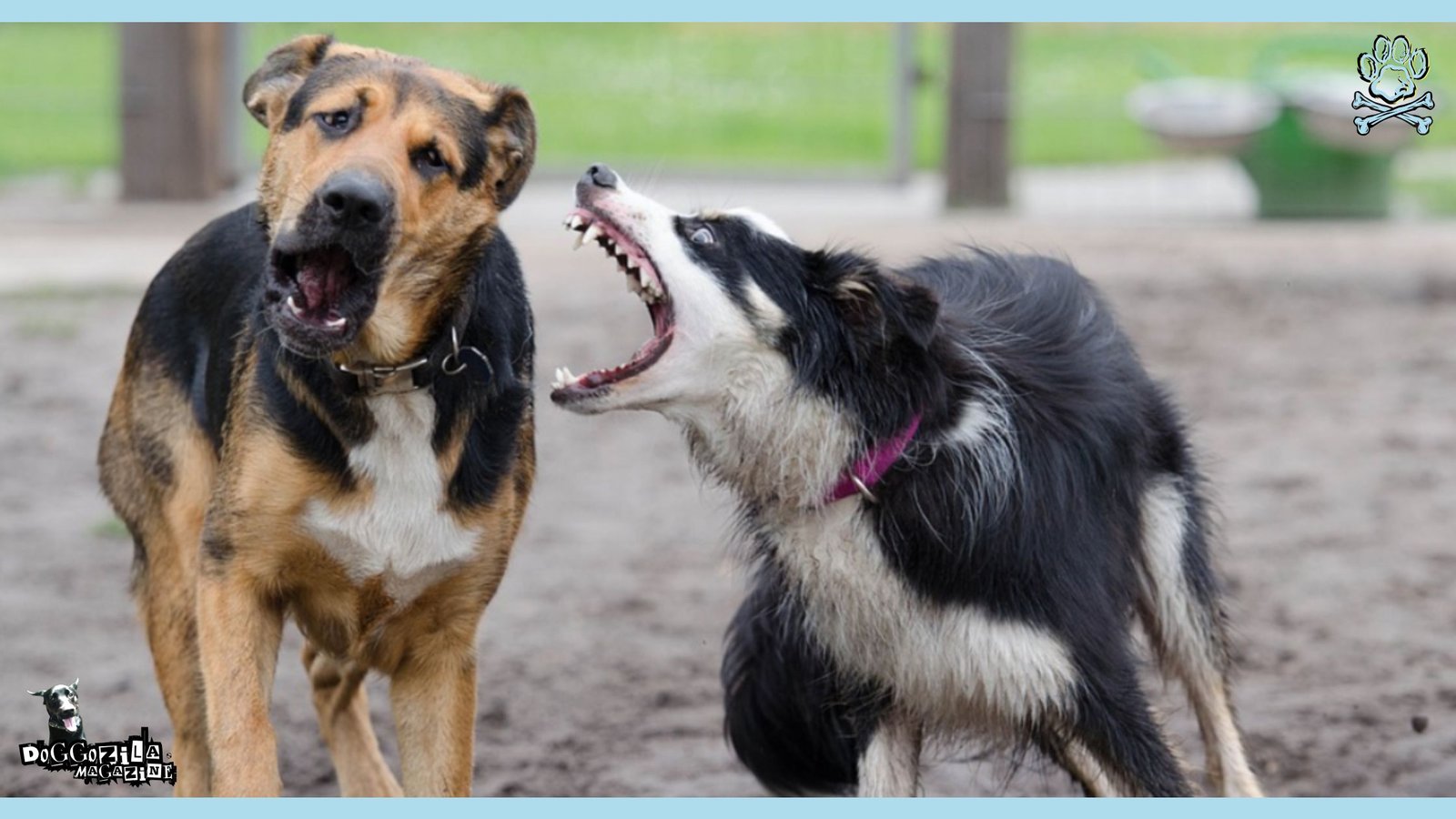
Fun Facts About Dog Play
- Dogs have a “play face,” where they open their mouths and relax their facial muscles. It’s their way of saying, “I’m just playing!”
- Puppies learn bite inhibition through play. If they bite too hard, their littermates will yelp and stop playing, teaching them to be gentler.
- Play is a form of communication. Dogs use it to build trust, establish boundaries, and strengthen social bonds.
Final Thoughts on Are Dogs Playing or Fighting? You Be the Judge
Understanding the difference between play and fighting is all about reading your dog’s body language. Playful dogs are loose, wiggly, and full of joy, while fighting dogs are tense, focused, and intense. By keeping an eye on their behavior and intervening when necessary, you can ensure that playtime stays fun and safe for everyone.
So, the next time you see two dogs tussling at the park, take a closer look. Are these dogs playing or fighting? With this guide, you’ll be able to tell in no time. Now, go out there and enjoy some quality playtime with your pup—just keep an eye on those play bows!

